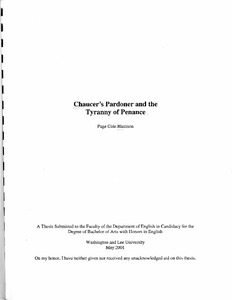| dc.rights.license | In Copyright | en_US |
| dc.creator | Harrison, Page Cole | |
| dc.date.accessioned | 2023-10-20T18:01:53Z | |
| dc.date.available | 2023-10-20T18:01:53Z | |
| dc.date.created | 2001 | |
| dc.identifier | WLURG038_Harrison_thesis_2001 | |
| dc.identifier.uri | https://dspace.wlu.edu/handle/11021/36556 | |
| dc.description.abstract | In the context of the tale-telling game that frames the Canterbury Tales, the reader anticipates a wide variety of different stories and forms as each pilgrim takes his or her tum. What we do not anticipate, however, is that the Pardoner and the Wife of Bath will both tum the prologues of their tales into something starkly original. Not only are these two prologues unusually long, they also do something no other prologues do. The Pardoner and Wife both make their "professional" lives the subject of a drawn out narrative, which takes the place of their tale as the central focus of the text. What strikes the reader even more, however, is that the means by which these prologue narratives are spun is a kind of "confession," in which the two pilgrims air their respective sins to the group. In both prologues, the reader (and presumably the pilgrim group) is left to question these pilgrims' motivation in publicly announcing their sins. If we look at the whole of the Pardoner's text, however, -- prologue, tale, and epilogue -- it becomes apparent that the Pardoner is performing, not just confession, but a version of the whole Sacrament of Penance. If we compare the Pardoner's text to the orthodox version of penance, both the ways in which he deviates from this model and the ways in which he conforms, should provide us with significant insights into what the Pardoner is attempting to accomplish through his use of these forms, and thus give us an insight into
his underlying psychology. In order to understand confession, one must evaluate it in the larger context of the Sacrament of Penance, of which it is only one -- though a very crucial -- part. To grasp what the Pardoner may have been trying to accomplish with his "confession," we must first understand what the medieval Christian expected to accomplish through the successful completion of the entire sacrament. [From Introduction] | en_US |
| dc.format.extent | 84 pages | en_US |
| dc.language.iso | en_US | en_US |
| dc.rights | This material is made available for use in research, teaching, and private study, pursuant to U.S. Copyright law. The user assumes full responsibility for any use of the materials, including but not limited to, infringement of copyright and publication rights of reproduced materials. Any materials used should be fully credited with the source. | en_US |
| dc.rights.uri | http://rightsstatements.org/vocab/InC/1.0/ | en_US |
| dc.subject.other | Washington and Lee University -- Honors in English | en_US |
| dc.title | Chaucer's Pardoner and the Tyranny of Penance | en_US |
| dc.type | Text | en_US |
| dcterms.isPartOf | WLURG038 - Student Papers | en_US |
| dc.rights.holder | Harrison, Page Cole | en_US |
| dc.subject.fast | Pardoner's tale (Chaucer, Geoffrey) | en_US |
| dc.subject.fast | Penance in literature | en_US |
| local.department | English | en_US |
